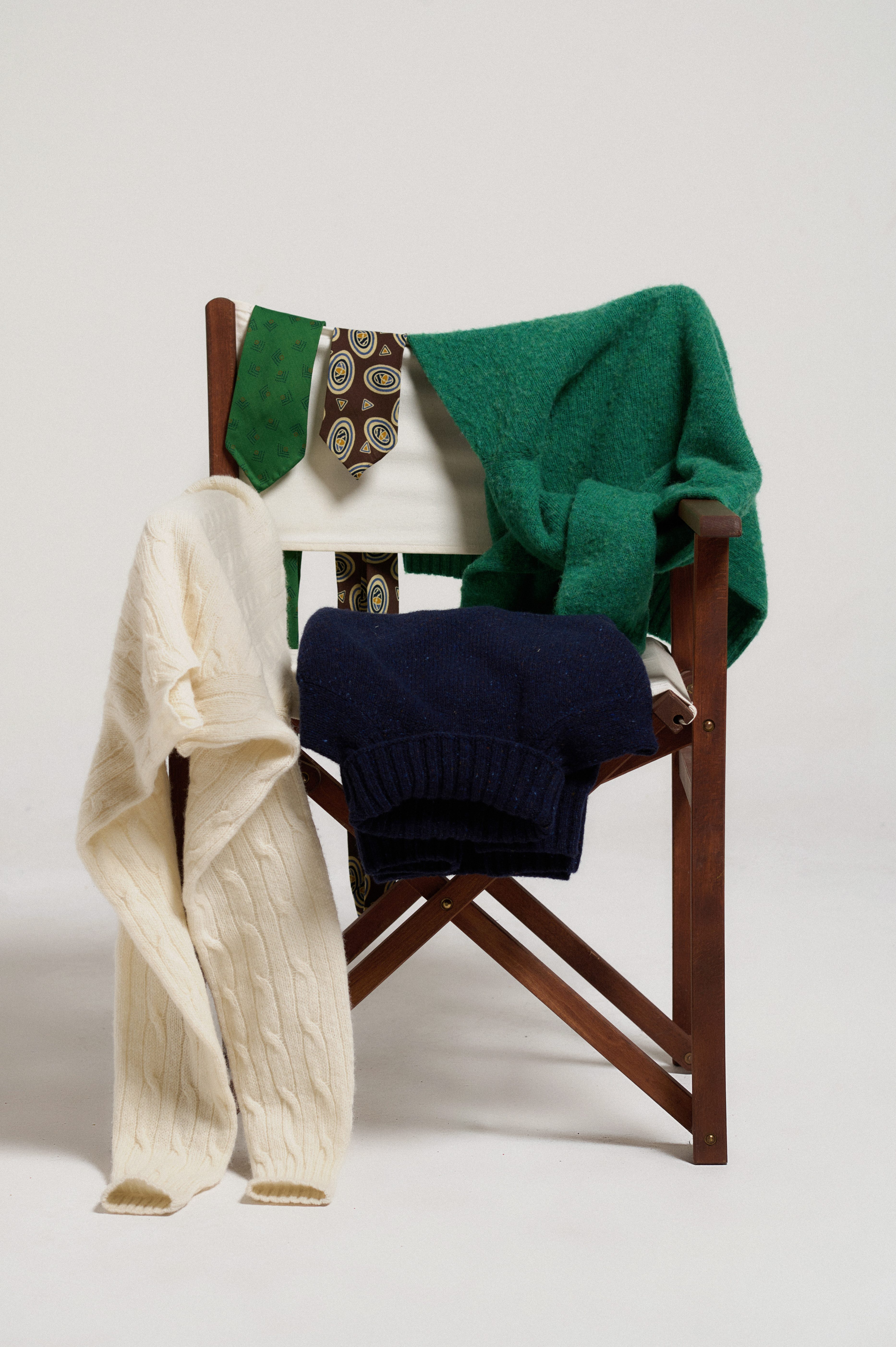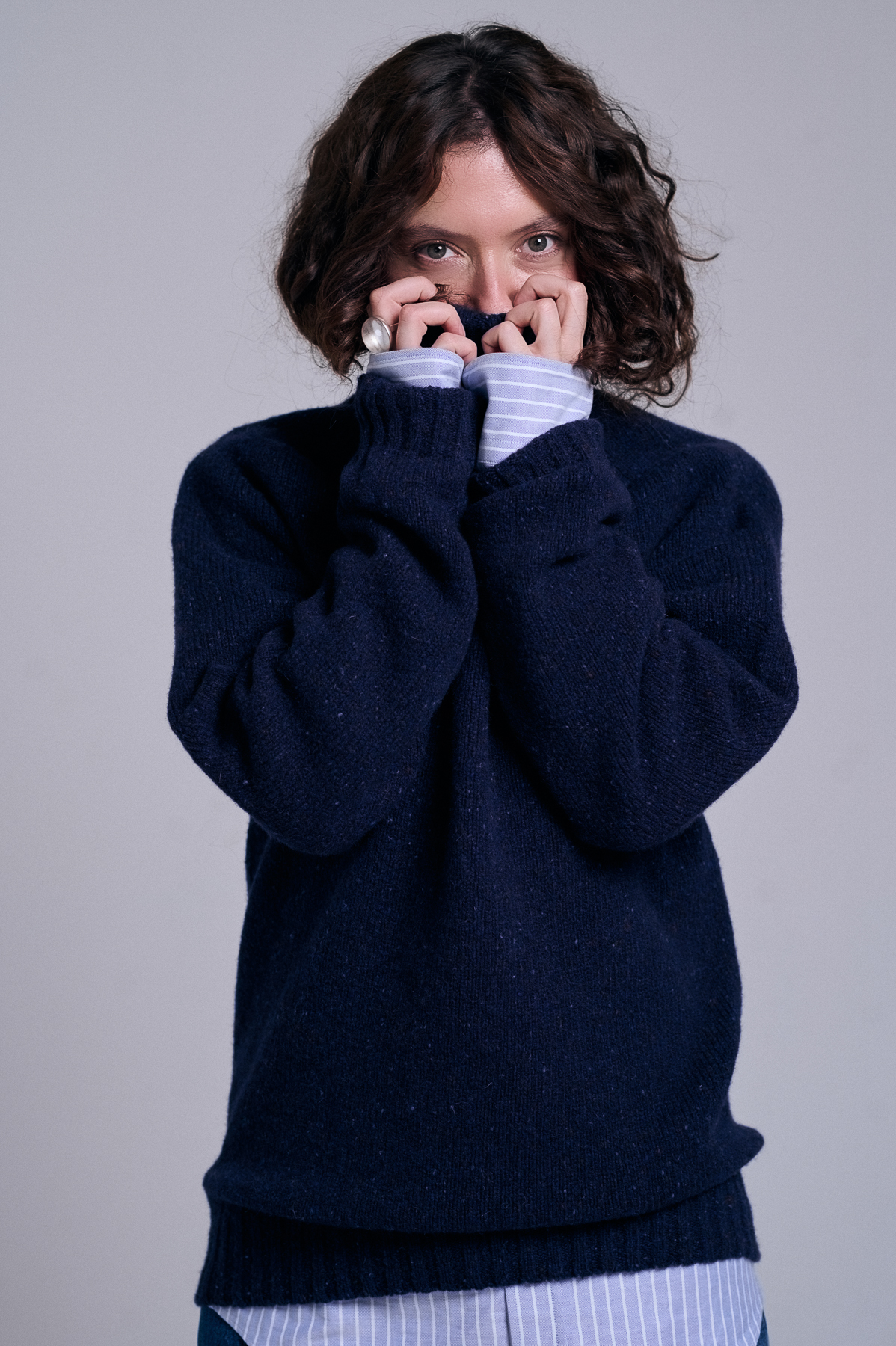A Shetland Sweater Story

When you really get into something, like we and our love for clothes, you eventually come across things that feel both fresh and familiar; ones that give off a sense of newness and nostalgia at the same time. Often it is because you've read and researched about them so extensively that you’ve reached the point where even without physically experiencing them, it feels like you've owned them for ages.
For us, that’s about our Shetland sweaters this season. Surprisingly, this is the first time we've ever had sweaters like these, but they already feel like old favorites.

So, instead of just diving into presenting the products, today we would like to take a moment to delve deeper into the topic, starting off with a quick history lesson for some broader context.
The story starts back in the 9th century, during the time of the Vikings, when Norsemen colonized the land that we now call the Shetland Islands. Settlers brought sheep with them - and this seemingly small act started the breed we now know as Shetland sheep, which have been living on the islands ever since.


Fleece of these sheep produce reflects the rugged nature of the islands. The Shetland wool is tougher than the well-known merino; despite being not as fine, it is actually very soft and incredibly warm. Some people might find its rough texture a little itchy, but that can be easily handled with some garment brushing - we'll talk about this common practice later.
Back in those days, sweaters didn't even exist - the knitting technique hadn't been developed yet. It only became popular in the late Middle Ages and made its way to Scotland, including the Shetland Islands, in the 16th century. This breakthrough allowed people to make their own warm-but-lightweight, comfortable clothes at home, partly replacing whole sheepskins or expensive loom-woven cloth.

Wherever there was plenty of sheep and the weather was cold, knitting became a common thing to do. It was not only affordable but also practical, especially for fishermen who benefited from the natural oils present in the wool, protecting them from getting soaked and providing some waterproofing.
It wasn't until the 19th century that Shetland wool products, like sweaters, hats, scarves, and socks, gained widespread recognition. At first, they were bought only by a few visiting merchants, but soon they became the main export and the foundation of the local economy:
Bartering goods was common in poorer areas of the UK until the Truck Acts came into effect. Even with the unfavorable exchange rate, some people had no choice but to use their homemade wool products as a form of payment for essentials like food.
Soon Shetland wool products, along with the distinctive Fair Isle pattern (named after one of the islands in the archipelago), started circulating more widely. At that time, most production for export was decorated this way - the distinction between the pattern and the type of wool used for production only became clear after World War II. But first, back when the terms Shetland Sweater and Fair Isle Sweater were still used interchangeably, this happened:

Edward VIII, then Prince of Wales (and already a celebrity), a very influential menswear figure, was photographed wearing such sweater. As you can guess, that brought them into the mainstream and solidified their place in men's fashion.
From there, their popularity spread like wildfire, reaching the east coast of the United States. Shetland sweaters became a staple of the Ivy League style and started to be viewed as something very American, despite its British origins - just like the polo coat, tweed jacket, and regimental tie. You probably know this photo, it’s 100% American Trad.
It's important to mention that when we talk about the Ivy/Preppy style, we usually have plain-colored Shetland sweaters in mind, as the Fair Isle pattern stayed more connected to the British Country style. Also, these are usually the brushed ones, treated with the technique meant to soften the wool that gave them the distinctive look.

In the past, this was done with the help of plants, natural brushes - teasels. Today, these are rarely used, manufacturers favor special brushes designed for the purpose (see the picture above).
Of course, you could leave the sweater in its raw form - today, it is more about the style than the softness. The more you brush the garment, the more textured it looks - from only slightly fuzzy single or double brushed sweaters, through the classic “shaggy" effect (worth mentioning that the J. Press’s Shaggy Dog version became somewhat of a cult product), up to some hardcore quadruple or quintuple brushed garments bordering on the felted look.

To sum it all up: we've explored a rich history that goes from the early Middle Ages to post-war times, covering colonization, economics, fashion and product trivia. And what about today?
Nowadays, the heritage of Shetland wool is highly valued. Since 2011, Native Shetland Wool has been granted the Protected Designation of Origin (PDO) status by the European Union, recognizing its unique qualities - interestingly, it ****was the first UK non-food and drink to be awarded. This status ensures that Shetland wool is produced entirely in the Shetland Islands, using wool from Shetland sheep and following specific production methods.
However, in reality, this status is reserved only for a small group of local spinners and knitters. The majority of Shetland wool production shifted from the archipelago to northern Scotland in the first half of the 20th century. Luckily, the change doesn’t mean any downgrade in quality - we just have to remember that to keep the authenticity of the Shetland wool feel, it's crucial to use wool only from the Shetland breed sheep (raised in a properly cold climate, we should add) and handle the yarn according to traditional practices. Usually, keeping the whole process local, from the animal to the finished garment, ensures that the every stage will be handled by experienced specialists who know their craft.

As you see, making a high-quality sweater is no easy task - perhaps this is the reason for the fact that our Shetlands debut took place only this season. We spent quite a lot of time ensuring they are made up to our expectations, but we're proud to say these go above and beyond them.
Our Shetland sweaters are made from the wool of Shetland sheep and the whole production process takes place within a few kilometers in northern Scotland. Our sweaters are knitted by a local factory with a hundred-year knitting tradition, which also happens to knit sweaters for some of the best shops around the world.
For our debut collection, we've prepared a total of 6 models, including turtlenecks, cable crewnecks, and classic crewnecks. Half of the collection is part of the Baltic Poszetka x Mr.Vintage collaboration, while the other three models feature non-Baltic colors that fit with our regular collection. To make it easier for you, we've arranged them in pairs: two turtlenecks, two cable crewnecks, and two classic crewnecks.


Let's start with the classic crewnecks, which really capture the essence of Shetland knitwear. They're inspired by the Ivy League style but have a universal appeal that makes them suitable for almost any wardrobe. We chose a double brushed finish that works beautifully with such bright, expressive colors, softening them up and adding a subtle texture.
The amber shade brings vibrancy to our Baltic color palette but is not limited to it; it naturally goes with pieces from our regular collection, as well as classic pieces like blazers, jeans, or gray flannels. The vivid, grassy green is another versatile option, complimenting not only the classics, but also multi-colored rustic textures in browns and greens, like the check pattern on our single-breasted coat.
These sweaters also act great as a sole pop of color in an otherwise monochromatic outfits, based on a gray and/or black.


Next up: cable-knit crewnecks. A slightly more sedated option for those who look for the Shetland’s warmth and softness, with an interesting weave that adds texture to the knitwear, with no wild color or brushing treatment to steal the show.
This classic sweater works great as a layer over a shirt for a polished (or polite, one might say) look, or on its own on a warm autumn/spring day. You can even wear it as a base layer under a winter suit or a sportcoat, if you wish too look a bit artsy.
Color choices are pretty self-explanatory: white and gray both versatile and timeless choices for a crewneck jumper.


For those looking for the ultimate warmth, we have turtlenecks. Knitted from a much thicker yarn than the typical merino sweater (and just a tad thicker than our other shetlands), they bring in a fisherman or lighthouse keeper vibe.
The thick white turtleneck also has some aviation connections - such was a part of the RAF pilots' uniform during World War II. It goes naturally with short jackets (like a harrington) and workwear-inspired outfits.
The navy blue turtleneck, also thick, warm and comfy, is knitted using a textured yarn that reminds of donegal tweed. Its non-uniform speckled appearance, with hundreds of small, colored flecks, makes it easy to pair with various shades of blue (including jeans). It stands out even when worn alone, thanks to its varied texture.

That’s it, I don’t think I have anything more to add; despite maybe trying to convince you to try one of these pieces if you haven’t yet. It’s definitely worth it!
However, I won't be surprised if, after reading such a lengthy article, you will also come to the conclusion that all these sweaters seem somehow familiar, yet new.